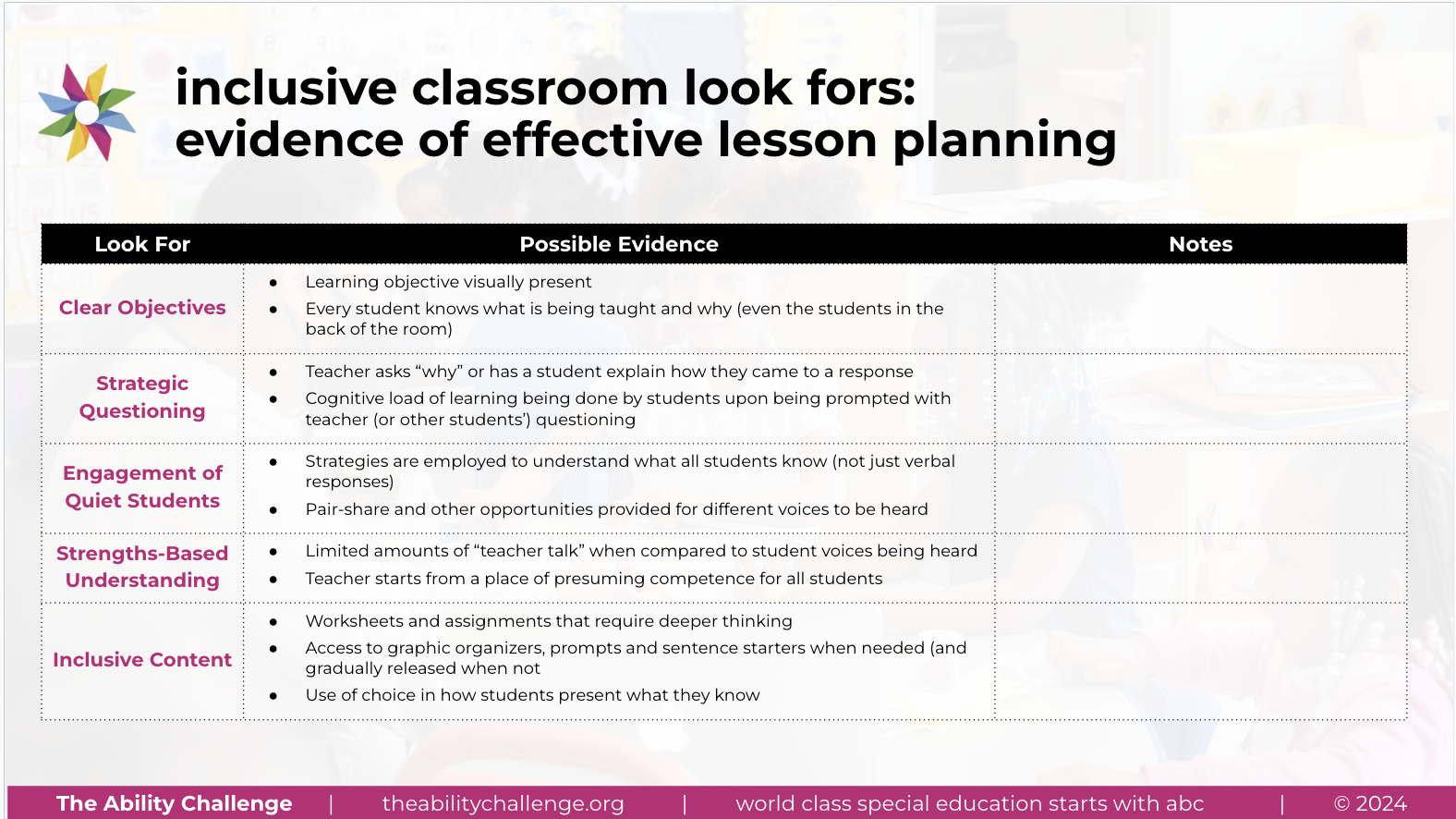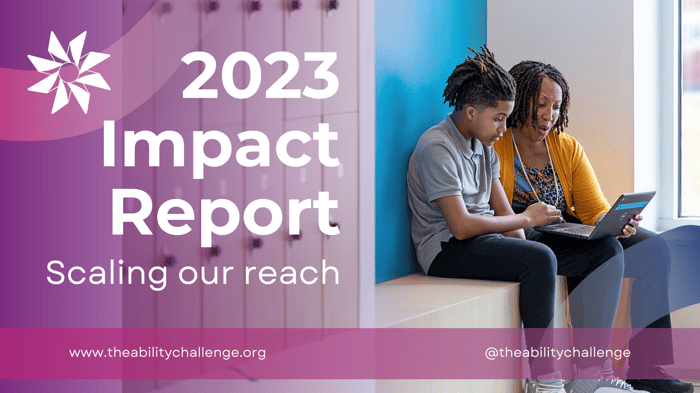Creating Inclusive Classrooms that Support Diverse Learners: A Model for Coaching Teachers
Administrators • 5 min read • Mar 27, 2024 6:45:00 AM • Written by: Sarah Sandelius
/AppleTree%20Case%20Study%20Shots/2023.01.24%20ABC%20AppleTree11.jpg)
In today’s classrooms, student needs are broad, encompassing a spectrum of learning styles and a range of abilities. Additionally, many teachers lack the necessary training in differentiated instructional strategies and the foundations of special education that are necessary to meet the needs in their classrooms. Further, when you factor in the ongoing challenges with scheduling and the lack of adequate time for planning with colleagues, cultivating environments that cater to every student becomes even more daunting.
In our work with partners, ABC has seen tremendous growth when working with leaders to provide consistent coaching and feedback to teachers on their inclusive instructional practices - effectively, “coaching the coaches.” Our coaching model is memorialized in this blog and the accompanying Inclusive Classroom Look Fors Tool. 
Why Coaching Is Important
Coaching enables leaders and teachers to establish a shared vision and understanding of what effective inclusive instructional practices look like in action. Through coaching conversations leaders can provide real-time feedback to educators in a way that leads to those crucial “aha moments” and shifts educator practice. While many leaders often seek answers for better serving diverse learners through new curricula or intervention tools, curricula alone cannot address the intellectual preparation and planning required for effective, inclusive, engaging, and differentiated lessons. Coaching, with the support of data collected during classroom observations, helps connect the dots in real-time in a way that other types of professional development cannot.
/AppleTree%20Case%20Study%20Shots/ABC%20SOAR_%202023.01.26_TwoRivers77.jpg?width=1200&height=800&name=ABC%20SOAR_%202023.01.26_TwoRivers77.jpg)
Key Definitions
Before launching any coaching, aligning on key concepts and terms is important. Having a shared understanding of what you expect to see in inclusive classrooms starts with foundational knowledge.
Special Education is a tailored approach to learning that addresses the unique needs of students with disabilities, providing them with individualized support and accommodations to help them succeed academically and socially. This includes a child’s whole program, including any related or specialized services needed to make progress in school.
Instructionally, this means that a student has (1) their specific barriers to learning removed (e.g., learning gaps are remediated) and (2) access to grade-level content to the greatest extent possible.
Specially Designed Instruction (SDI) refers to the personalized teaching methodologies, materials, and techniques tailored to meet their unique needs, ensuring their access to the general curriculum and enabling them to make meaningful educational progress.
How is SDI different from differentiation?
Differentiation is the hands-on learning, small group activities, and planning that seeks to engage various student learning styles and needs.
While differentiation is planned before a lesson in anticipation of different groups of learning needs in a classroom, SDI is crafted for a specific child in the first instance. However, it can also be extended to the whole class. When both are done well, a leader may not be able to distinguish the two, but it is clear to see how each student is getting what they need from a single lesson.
/AppleTree%20Case%20Study%20Shots/2023.01.25%20ABC%20Training%20AppleTree_038-1.jpg?width=1200&height=800&name=2023.01.25%20ABC%20Training%20AppleTree_038-1.jpg) Evidence of Effective Lesson Planning
Evidence of Effective Lesson Planning
While coaching for equity can take many forms and focus on a range of topics, we like to start by looking for evidence of effective lesson planning that can be observed in inclusive classroom instruction.
Teachers who plan lessons that consider the wide spectrum of needs in their classrooms create an environment where diverse learners can connect deeply with the content. The practices outlined below play a pivotal role in a teacher’s ability to foster an inclusive and impactful educational environment. When observing instruction, school leaders should look for evidence of these features in a teacher’s practice.
Clear Objectives: A well-structured lesson includes clearly written and discussed learning objectives that challenge all students and provide a sense of purpose. For diverse learners, clear objectives help students connect the learning tasks for the day with the ultimate goal of instruction and serve as helpful reminders throughout the lesson as needed.
Strategic Questioning: Questions that encourage students to take on the cognitive load in the classroom provide opportunities for teachers to understand student learning and identify more precisely where students may need more targeted instruction. Often crafting these questions can feel daunting, however asking students to explain their thinking through asking “why” more often encourages a deeper understanding of concepts through critical thinking. Varied question types and strategies for questioning (e.g., warm calling, structured choice questions, giving a heads up on a question, etc.) provide a means of engaging students who may require more processing time or who are less confident sharing in class.
Engagement of All Students, Especially the Quiet Ones: Observing the engagement levels of quieter students or those not actively asking questions can provide insight into how inclusive and accessible the teaching strategies are. Too frequently, most of our attention stays on the louder, disruptive students, but many of our diverse learners stay under the radar.
Strengths-Based Understanding: Designing instruction to meet students' strengths promotes content mastery and personal growth. When teachers start from a place of presuming competence for each student, evidence will show in their relationships with students, in how they provide opportunities for students to show what they know (and not just what they don’t know), and in how much “teacher talk” is happening in a given classroom.
Inclusive Content: Making deliberate decisions about instructional materials to meet individual student needs supports student autonomy and engagement. Ensuring that students can see themselves in the curriculum and connect back to prior knowledge taps into student interests which can be especially helpful for some diverse learners. Indeed, varied and multiple opportunities for demonstrating mastery allow for a deeper understanding of students’ needs, driving planning and preparation to inform instructional decisions.
/AppleTree%20Case%20Study%20Shots/2023.01.24%20ABC%20AppleTree11.jpg?width=5000&height=3335&name=2023.01.24%20ABC%20AppleTree11.jpg)
Putting it All Together
As you coach, consider it an opportunity for teachers to hone their instructional practice with critical strategies that support all students through reflection, thought partnership, and meaningful feedback conversations. The ultimate goal is to ensure that all of your students, including diverse learners, access rigorous, meaningful, grade-level content in a way that meets their needs.
Transforming education to serve students with diverse learning needs is not a solitary journey but a collaborative effort that requires the right expertise, resources, and dedication. Through our work, The Ability Challenge empowers educators to build inclusive communities where every student is seen, valued, and given the opportunity to reach their full potential. Together, we can redefine what it means to provide a quality education, ensuring that no learner is left behind in the pursuit of excellence.
* * *
Click on the image below to download your copy of the Inclusive Classroom Look Fors Resource
Ready to Make an Impact For Your Most Diverse Learners?
Sarah Sandelius
Our Latest
Related Articles

January 31, 2024 | Our Work
2023 Impact Report: Scaling our Reach
Explore The Ability Challenge's 2023 wins—enhanced training, coaching, and professional development ...

March 9, 2021 | Teacher Training
A Breakthrough: Avoiding Burnout
Empower Teachers and Students: discover practical strategies to prevent burnout, manage stress, prio...

August 13, 2024 | Administrators
An Administrator's Essential Guide for Establishing a Culture of Inclusion
Learn how school leaders can foster inclusive education from day one. Practical strategies for admin...
